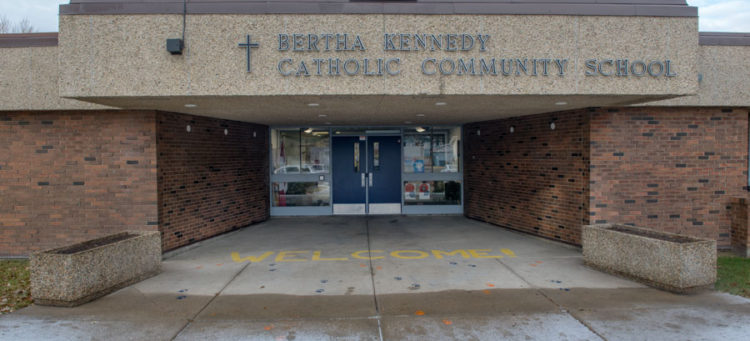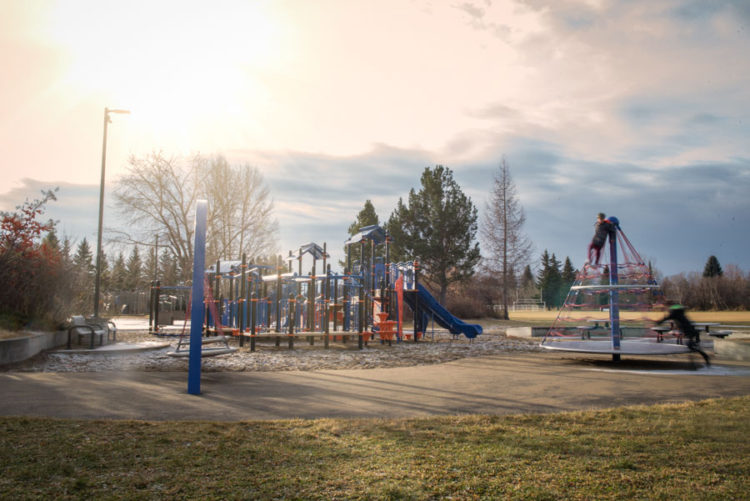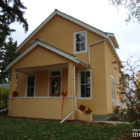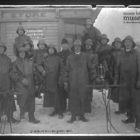
Then & Now
Bertha Kennedy Catholic School: One Classy Tribute: stands as a legacy to a decorated citizen
November, 2019
When Bertha Kennedy Catholic School opened, the average Canadian family income was slightly more than $50,000 a year, Mark Messier was a scoring dynamo with the Spruce Grove Mets and the closest thing we had to hand-held technology was the pocket calculator. How things have changed, including the education contributions made by the school, named after a former teacher who was also the 1975 St. Albert and District Chamber of Commerce Citizen of the Year. Recognizing the notion of involving more than just students, the school has fittingly played an important role in blending community and education in St. Albert for over 40 years.

1970s
In March 1977, an official ribbon-cutting ceremony was held for a new school called Bertha Kennedy Community Core School. Local dignitaries, board members, teachers, parents, students, and of course, the guest of honour, were all present to watch the evening unfold. The celebration concluded with MLA Ernie Jamison speaking of the inspiration that students could take from the name of their new $1-million K-8 school before cutting the ribbon, officially opening its doors to 250 young new pupils.
In May 1977, Bertha Kennedy Principal Ross Johnson told the Trustees of School District 3 that the concept of “community education” was reliant upon three components—the community use of schools, the involvement of parents in many areas, and staff involvement in the community—three areas where Johnson believed to have made progress. Since opening, the school had begun hosting a variety of different sport and recreational activities for the community to take part in, such as gymnastics, basketball for mothers, macramé for children and parents, as well as volleyball and floor hockey. Parents were also becoming much more involved in the day-to-day life of the school by acting as teacher aides, lunchroom supervisors, and helping with field trip transportation. The school had even been the scene of various religious exercises, including one baptism held in class.
1980s
In 1982, Bertha Kennedy made provincial headlines with its PLATO (Programmed Logic for Automatic Teaching Operations) Computer, the first in all of Alberta. The computer offered digital learning programs to students in a range of subjects. The most popular of which were Hangman (language arts), Pizza Fractions (math), and Africa (social studies). Students were each assigned their own password for the computer and were able to book 1.5-hour slots after school when they could come in and work on the computer with their parent’s supervision.
1990s
In the mid-1990s, when POG games or “milk caps” were all the rage, the St. Albert RCMP came up with a crafty plan to promote drug education among children in the community. In May 1995, local officers visited Bertha Kennedy with a set of 39 cardboard POGs for Grades 1-6 students featuring photographs of themselves, along with the anti-drug slogan “Say No to Drugs.” As elementary school is typically the best time for police to make initial contact with children, the goal of this venture was to connect and familiarize the local RCMP officers with students to prevent them from getting into trouble, rather than having to deal with them after the fact.
2000s
Bringing agriculture into the classroom through indoor gardens was an idea and exercise that began to grow in Edmonton area schools during the 2000s. By 2008, Bertha Kennedy was participating in something called the “Seed to Salad” program, where students experienced the food production cycle of vegetables, herbs, fruits, and flowers first-hand. Students gained a direct and personal understanding of how plants were grown and harvested for food as they would water, transplant, prune, and harvest their own vegetables which they would use to prepare fresh salads, fruit skewers, and soup.
2010s-Today
Today, Bertha Kennedy, led by Principal Anna-Lisa Doll, and Vice-principal Cindy Pereira is a Pre-Kindergarten to Grade 6 Catholic school which provides universal, targeted, and individualized academic and behavioral supports in its classrooms, while embracing learning environments that are inclusive, flexible, and responsive to students. t8n
Mary Bertha Kennedy (Brennand) (March 11, 1909-June 28, 2004)
Born in Lancashire, England on March 11, 1909, Kennedy came to Canada in 1921. After attending Normal School in Calgary during the 1926-1927 term, Kennedy found her first teaching position in Strome, Alberta.
In 1935, she married Andrew Kennedy, and moved to St. Albert in 1938. In 1940, the newlyweds moved onto a farm east of St. Albert where the Sturgeon Valley Golf Course operates today. In 1957, the Kennedy’s sold the farm and moved back to St. Albert, where Kennedy would teach at Mission Park School, École Father Jan, and Albert Lacombe Catholic School until her retirement in 1974.
Even after retiring from teaching, Kennedy was still ever-present in the community as a church organist, children’s choir leader, researcher in religious education, member of the town Historical Society, and a charter member of St. Albert’s first recreation board.
She would often visit Bertha Kennedy Catholic School until her passing on June 28th, 2004, at the age of 95.













